ARTH 219/LA 22; Islamic Architecture & Gardens - Exam 1
1/133
Earn XP
Description and Tags
Contains Vocab, readings, and Site IDs (only 23)
Name | Mastery | Learn | Test | Matching | Spaced |
|---|
No study sessions yet.
134 Terms
Ibn Asakir: The Pact of Umar
The Pact of Umar was a list of rights that gave protection in conquered cities to Christians and Jews (dhimmis). The pat was drawn after the conquest of Damascus and promised certain freedoms to the dhimmis for behavior and discretion.
Nasir-i Khusraw: A Description of Kaaba
This is an account of an eyewitness' description of the Haram Mosque and Kaaba he mentions the black stone corner and the textile covering (kiswa). He describes the seven gates on the exterior as well as the interior detailing things like columns, use of marble, silver mihrabs, planks from Noah's arc.
Dome of the Rock Inscriptions
One of the highest and most visible points in the city that had preexisting religious significance (place where Abraham was going to sacrifice his son). It is the earliest surviving Islamic work of architecture and contains the earliest bands of inscription, mostly consisting of Quranic passages.
Al-Baladhuri: How the Muslim Community Obtained the Site for the Mosque of Damascus
Al-Baladhuri relates the story of how the Muslim community of Damascus wished to demolish the church of St.John to build a new house of worship. He says that tried to purchase the church, however it was rejected twice and a caliph eventually deemed demolition.
Ibn Shaddad: On Rusafa
Rusafa was a Syrian city adopted and rebuilt by an Umayyad caliph. The city housed great water tanks that stored rainwater inside the waterless desert.
Al-Masudi: On the Founding of Samarra
An account of why the Abbasid caliph decided to quit Baghdad and search for a better site for his palace. The fiat city became overcrowded and the residents began complaining about the abuse of power from soldiers.
Kitab al-hadaya wa al-tuhaf: A Reception of Byzantine Ambassadors in Baghdad
The Fatimid author tells how two envoys went from Byzantine court to the Abbasid count to ransom Byzantines who had been taken prisoner/negotiate a peace treaty. They were smothered with opulence and wealth of the Abbasid court.
Ibn Idhari: On the Mosque of Cordoba
A description of the various stages of construction of the Great Mosque of Cordoba, it was at first a christian church, however it was purchased and demolished to build the mosque. They built a garden, courtyard, and a minaret.
Abd al Rahman I: Ode to a Palm Tree
A poem about an exiled Umayyad-Hispano caliph driven out of Syria by the Abbasids and his longing for his Syrian roots. It represents the hybrid culture of Umayyad Cordoba.
Ibn Ghalib: On the Construction of Madinat al-Zahra
Accounts of the construction of the great Umayyad palace city, Madinat al-Zahra. It details the splendor/majesty, as well as the accounting-material/labor cost of the project.
The Quran: On Paradise
The Quran depicts paradise as a garden with four flowing rivers and ripe fruit. This could be the written explanation of why there are four-part, cross-axial garden plans- essentially they were used to compare a garden to the paradise's beauty.
Mufaddal ibn Abi al Fada'il: On the Fatimid Processions to the Four Mosques
In the city of Cairo, the Shi'a Fatimids used a public display to position themselves in power over the Sunni population. They began parading on Successive Fridays to one of the four congregational mosques. Through this parade they were able to merge religion with politics and secular power.
Trabeated
Vertical columns holding up horizontal roof
Hajj
Muslim makes the trip to Mecca
Hypostyle
vertical columns, enclosed space, oriented towards mecca
Circumambulation
the act of walking around a sacred object or place
Mihrab
a marker—usually an arched niche—that identifies the qibla wall as the wall closest to Mecca
Minbar
small set of steps in front of the qibla wall, stood on to amplify voice over
Dhimmi
non-Muslims who lived in an Islamic state and were protected by law
Sunni
insist on the legitimacy of the Umayyad line
Shi'i
insist on the legitimacy of the prophet's line, through Ali and Fatima
Ambulatory
a semi-circular aisle that wraps itself around a central space
Kufic script
earliest extant Islamic style of handwritten alphabet
Spolia
the practice of reusing architectural elements from older structures in new construction
Nave
the central part of a church/mosque building
Cardo & Decumanus
cross axial street, cardo is vertical axis, decumanus is horizontal axis
Arcuated
arched
Khan / Caravanserai
small residential block that offered food, shelter, and water to travelers & merchants
Chahar Bagh
a garden that is divided into quadrants
Apse
a large niche
Merlon
solid portions of wall that alternate with empty spaces and together cap a wall
Iwan
a vaulted hall, closed at one end and open at the other
Noria
water wheel, pulled by an animal or propelled by a river or stream
Qanat
Underground aqueduct, leads from under a mountain to a city
Shaduf
a hand-operated device used to lift water from a body of water to land
Wadi
seasonal stream
Haram
reserved, private or sacred area
Iwan
like a hallway open on one end, usually arched overhead
Nine-Bay Mosque Type
a square-shaped mosque with four columns dividing the space into nine bays
Horseshoe Arch
a curved arch that widens at the top and narrows at the bottom, resembling the shape of a horseshoe
Voussoir
wedge shaped blocks used in an arch
Muezzin
the person who calls the faithful to prayer five times daily
Maqsura
A barrier around the mihrab (and possibly minbar) to protect the prince
Mirador
tower attached to a building and providing an extensive view
Ziyada
the outer enclosure of a mosque
Lustre Tile
type of metallic overglaze applied to ceramic and glass
Muqarnas
small curved niches stacked to create a honeycomb effect
Hadith
Sayings of the Prophet and reports based on observation of him and his practices
Skewed Façade
a façade that does not align with the building interior
Keel Arch
arch with straight sides that curve over the dome's shoulder and then flatten out again as they reach the apex of the dome
Mashhad
a shrine or commemorative mosque
Umayyad
7th-8th century
Abbasid Dynasty
8th-13th century
Hispano-Umayyad Dynasty
8th-11th century
Tulunid Dynasty
9th-10th century
Aghlabid Dynasty
9th-10th century
Fatimid Dynasty
10th-12th century
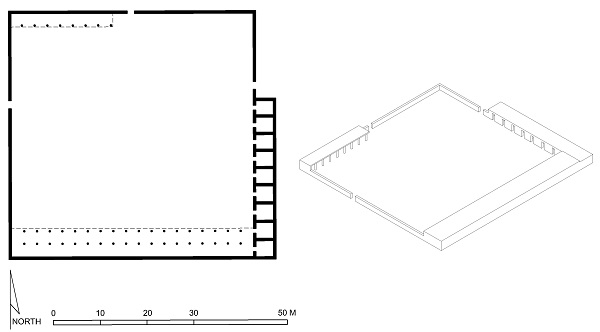
The Prophet's House, Medina, 7th century
- The space was oriented, allowing its occupants to align themselves in rows as they prayed in the direction of the Kaaba in Mecca
- The simple open structure was infinitely expandable, accommodating itself easily to the growing population of Muslims
- the space was egalitarian (status was nonexistent and all were treated as equals)
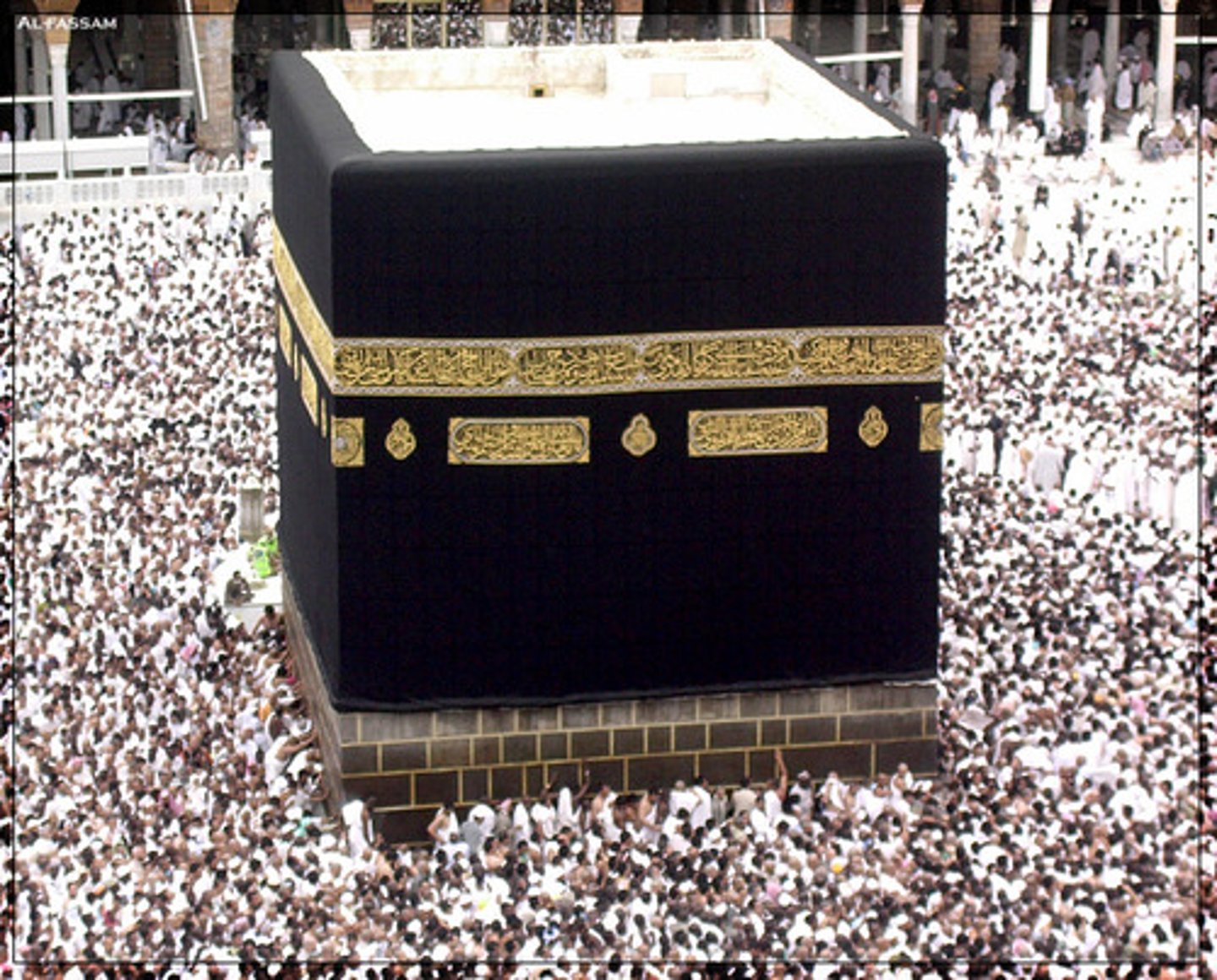
The Kaaba
Mecca, Saudi Arabia
- The Kaba is the building towards which Muslims face five times a day, everyday, in prayer
- millions of Muslims come from across the world to stay in huge tent communities in Mecca and to ritually circumambulate
- Symbolic Marker as the Center of Islam
- The Prophet (Muhammad) Cleansed the Kaaba of its Pagan idols and dedicated it to Islam’s One God
Contains an ancient meteor
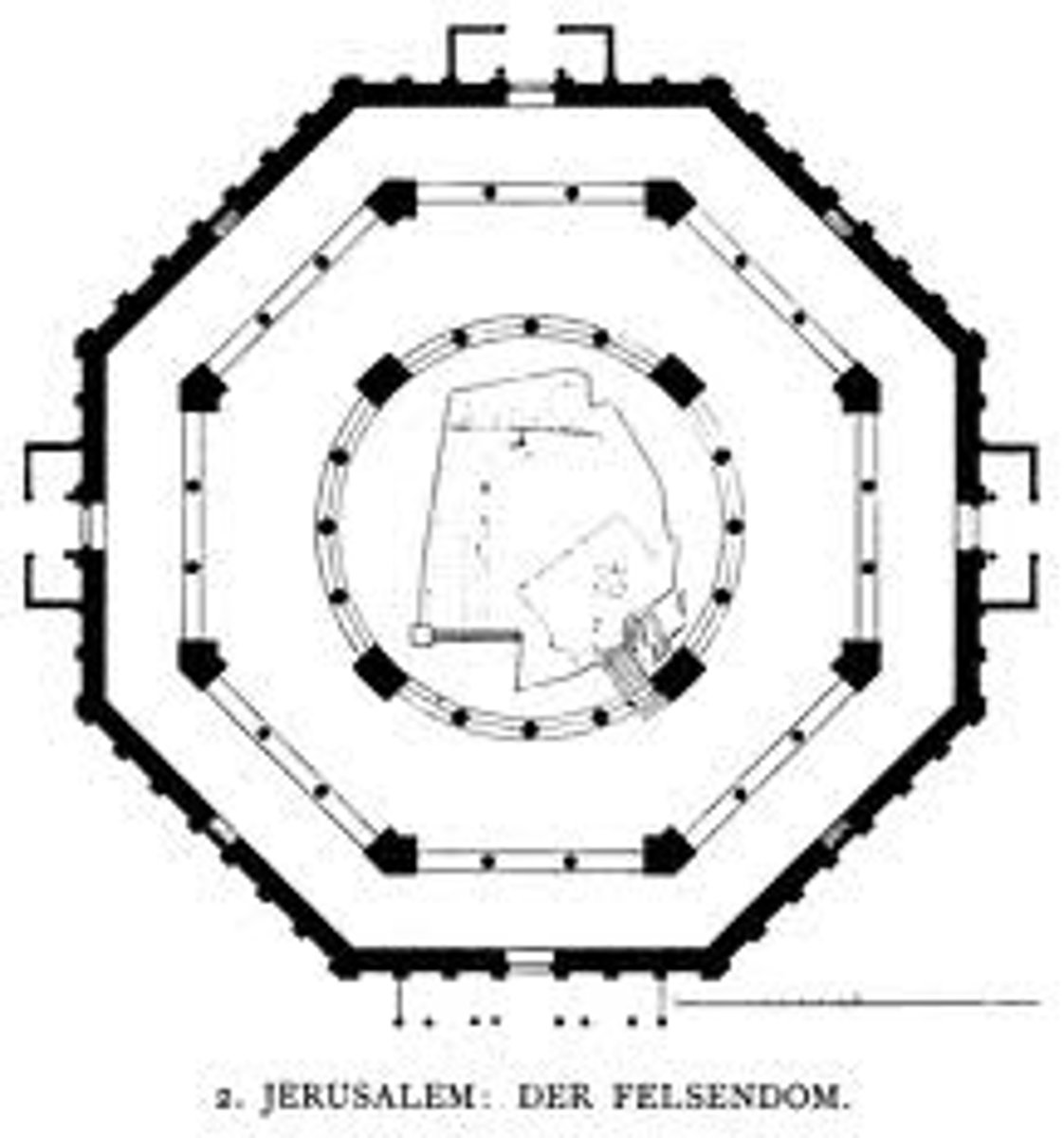
Dome of the Rock, Jerusalem, 7th century, Umayyad
- supposedly built on the formerly Solomons temple (seen as a victory monument)
- it is not a congregational mosque, because its construction is not well understood; still a place for prayer
- extensive mosaics that borrow inspiration and technique from the Byzantine Empire (Mosaic subjects, like crowns, jewels, and vines add to Victory element)


Mosque of Damascus, Damascus, 8th century, Umayyad
- First a Roman Temple, then a Christian Church, then finally a Mosque
- Double Arches in Interior: makes ceilings higher (Similar method used @ Cordoba)
- Byzantine mosaics on the Courtyard facade show scenes of paradise (afterlife is paradise)
- Perpendicular Nave
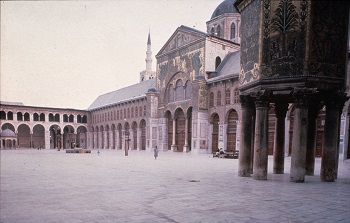
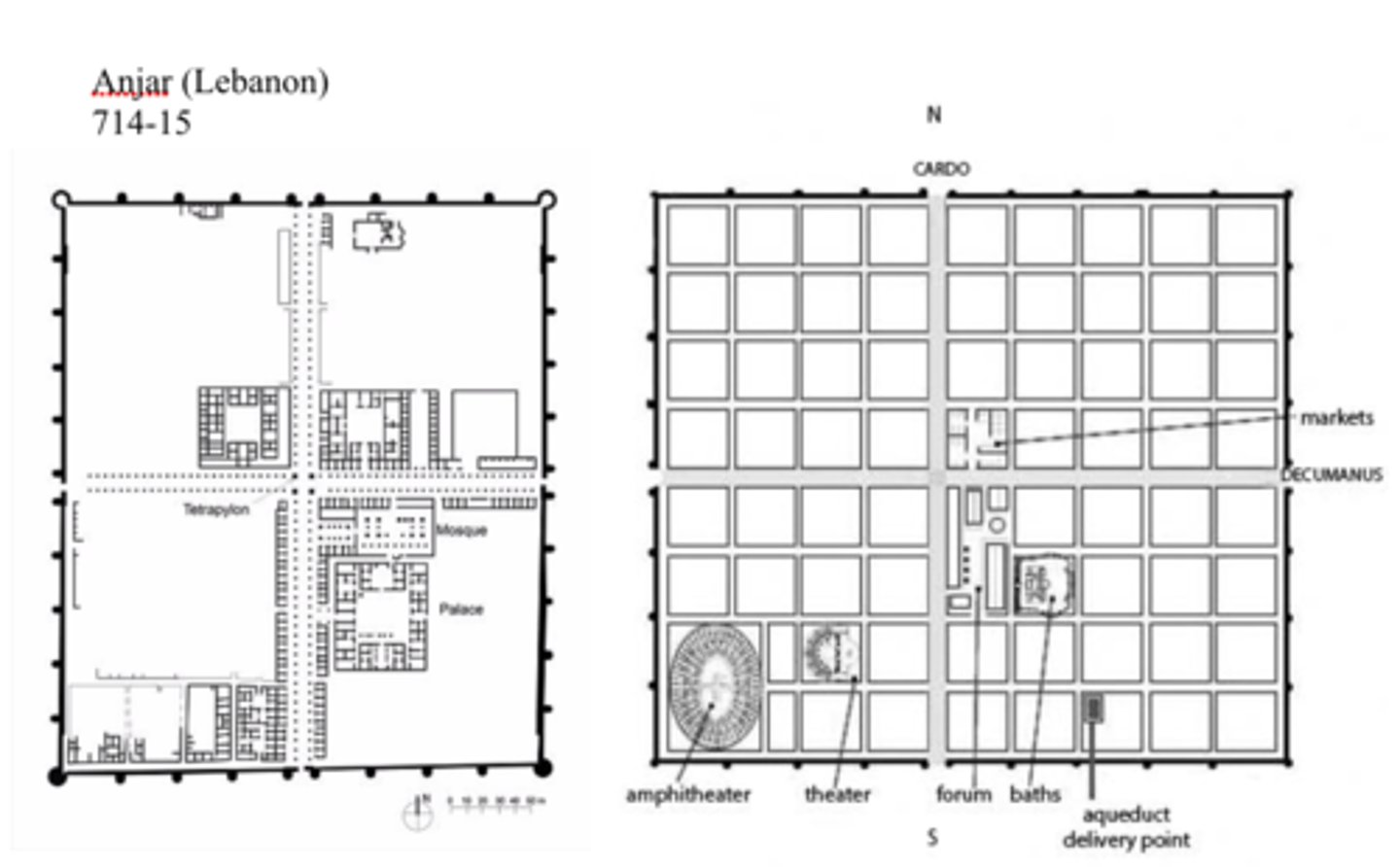
Anjar, Lebanon, 8th century, Umayyad
- Followed the system of Roman City planning (grid-like) with 4 city gates and two “main streets” running through
- The “cardo” (NS) and “Decumanus” (EW) Axis —> shops featured on the Cardo
- The Governor’s house was built and placed next to the Mosque for Safety Reasons
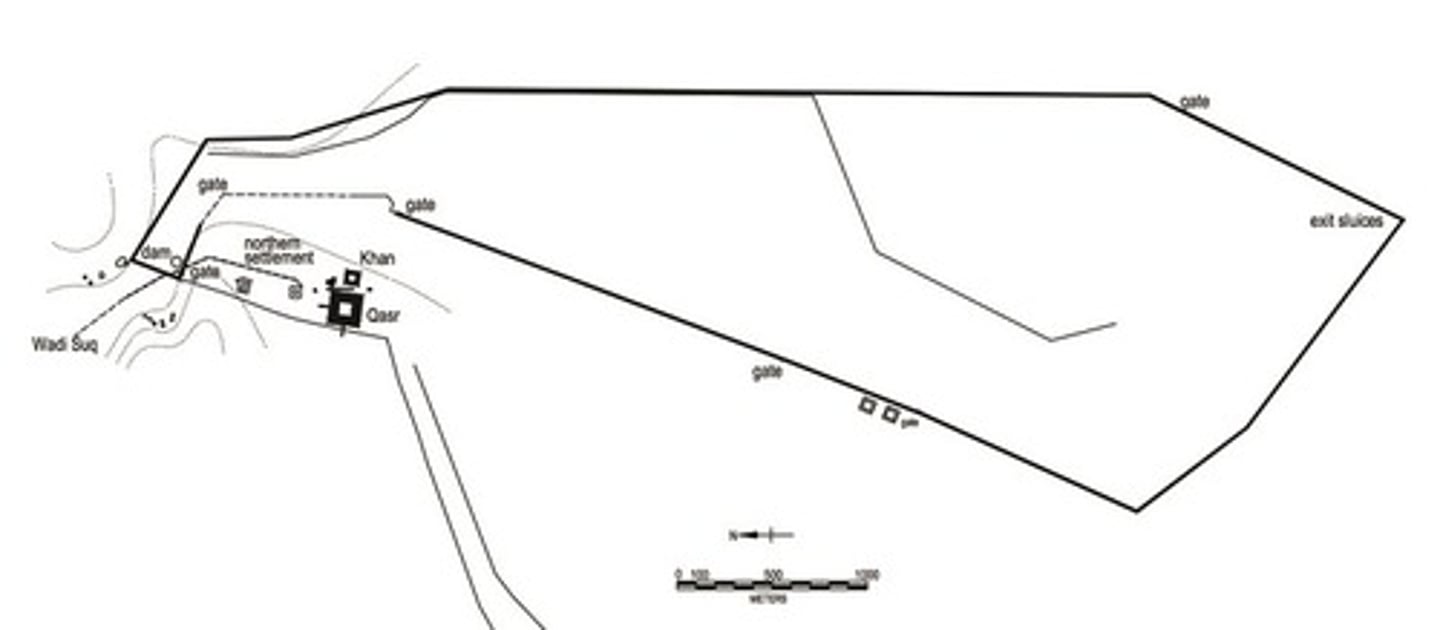
Qasr al-Hayr East, Syrian Desert, 8th century, Umayyad Dynasty,
Agriculture and trading settlement
- Enclosure would trap seasonal water from the Wadi, which enabled the cultivation of Olives
Sat on a trade route; herdsman/merchants stayed at the Khan
- has never been attacked but has strong defenses (missile balcony)

Khirbat al-Mafjar, Bath Hall; 8th Century, In Desert near Jericho, Umayyad Dynasty
Attached to palace; water was seen as a display of luxury and power
Caliph would show it of to local chieftains who came to visit
Floor Mosaic: Gazelles and the Lion (Peace vs. War) (Byzantine Mosaic)
Statue of Caliph also expressed power
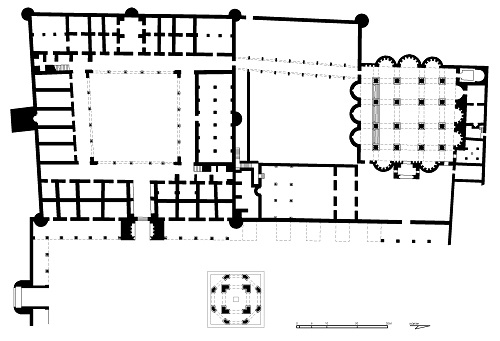
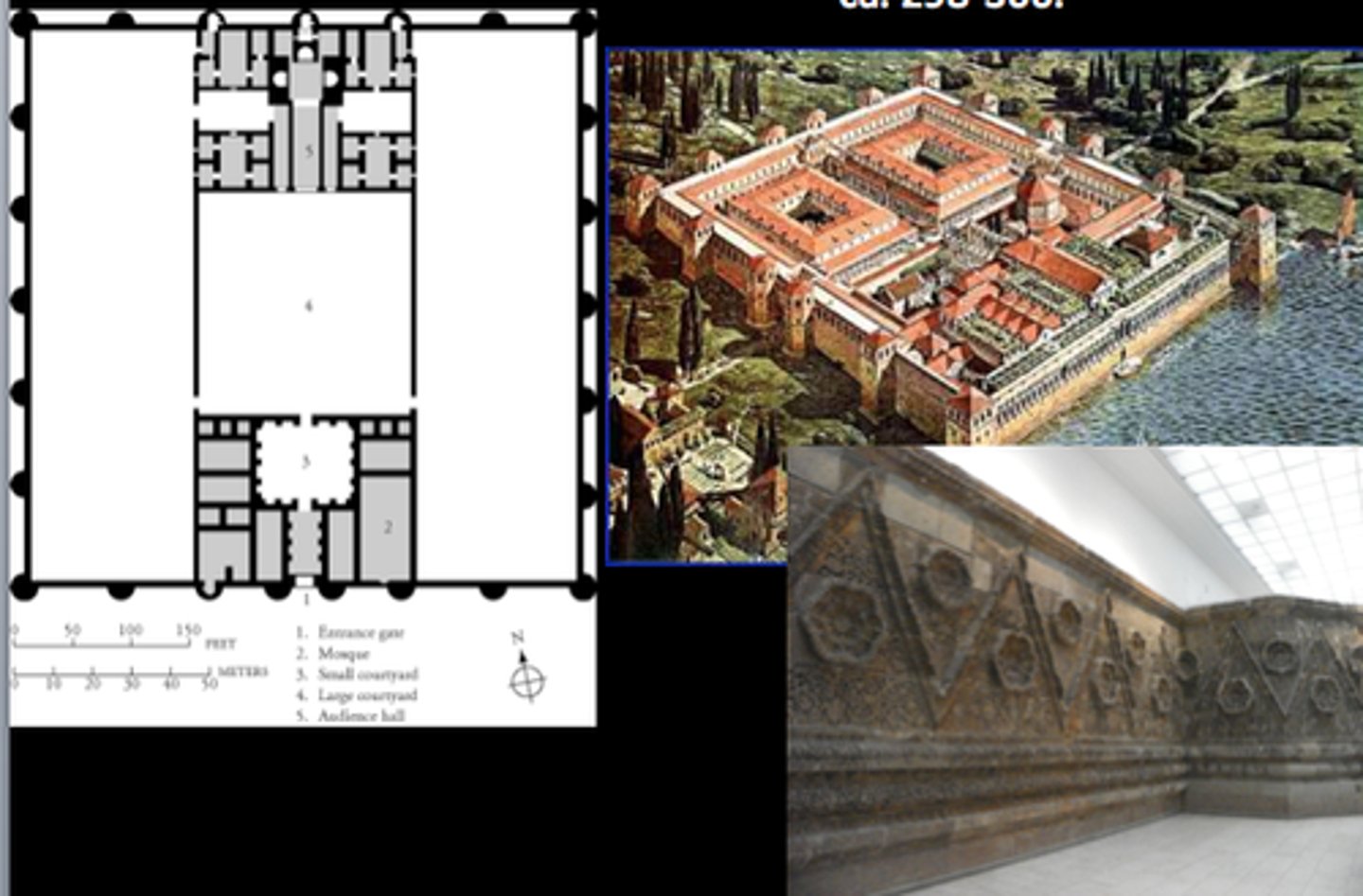
Mshatta, Jordan, 8th century, Umayyad Dynasty
- Vast rectangular + walled enclosure; divided in 3rds (Only central third was built)
Featured an elaborate throne room and ornamented limestone Facade; inspired by Byzantines with potted vines and leaves
Special Dome: emerges purpose of marking a special architectural place (Place of the prince, middle of the sphere, middle of Muslim world)
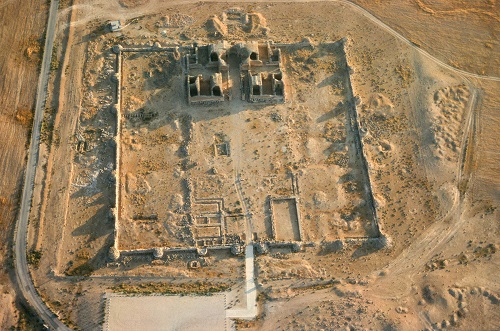
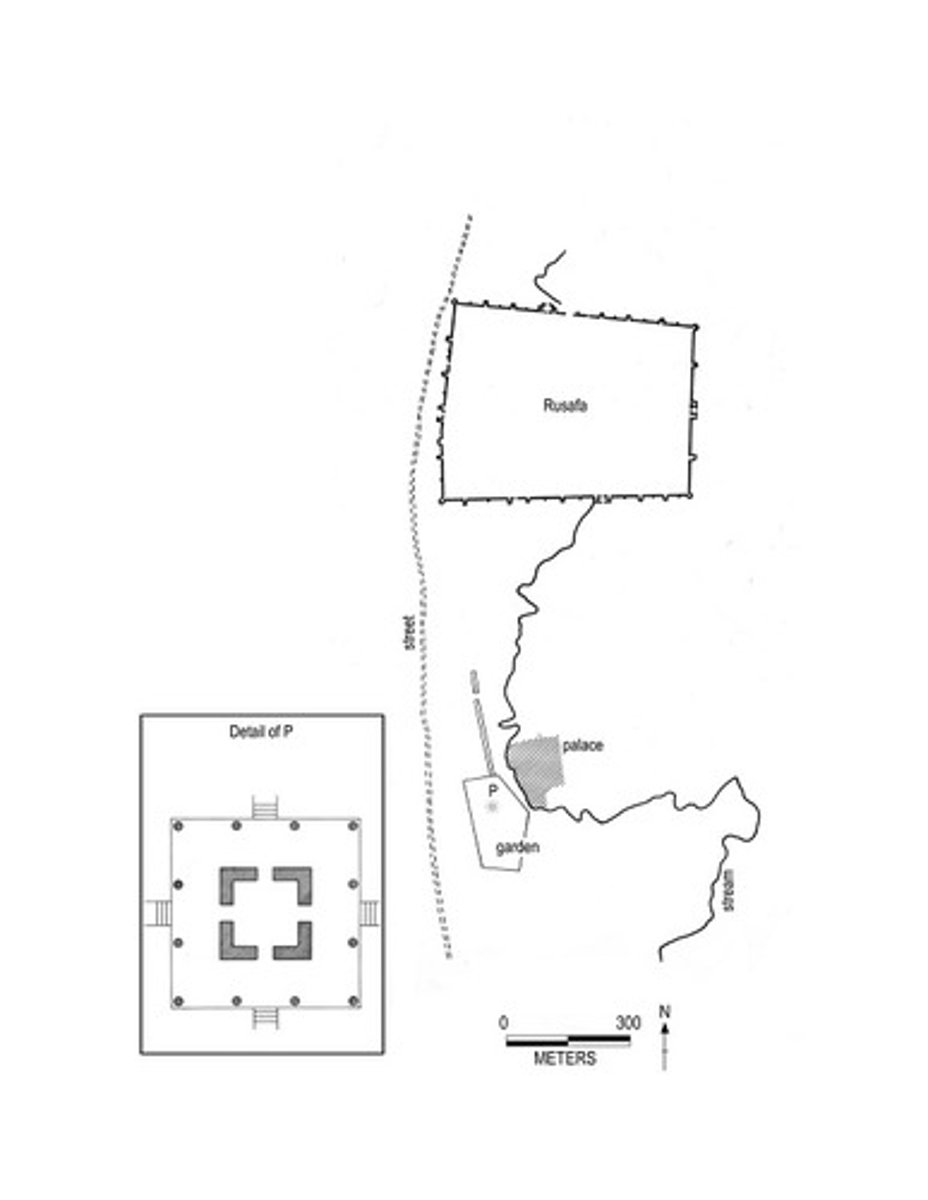
Rusafa (Syria), in the desert, 8th century, Umayyad,
- Agricultural estate? Hisham (Umayyad Caliph) adopted city as a country resort and as an escape from the congestion of Damascus
- may be the oldest surviving Islamic garden with the four-part plan called a chahar bagh —> Placed caliph at the Center of the garden (center of the visible world)
- it served as a good place to meet with tribal chieftains and negotiate while showcasing the water management
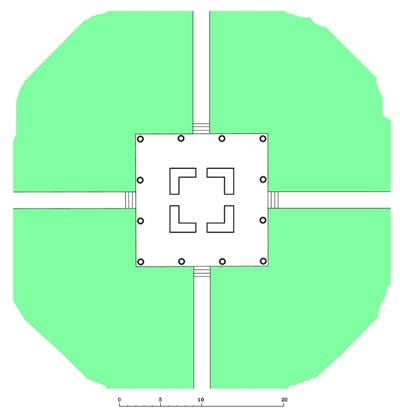

Baghdad, on the banks of the Tigris River, 8th century, Abbasid
Circular City —> made for horrible expansion (if you expand one, side you have to expand all sides)
Fiat City (Caliph/Patrons demanded it to be built and it was); Usually linear or rectangular
Soldiers towards the center lacked loyalty and were disrespectful
Caliph felt trapped in the middle, very overcrowded
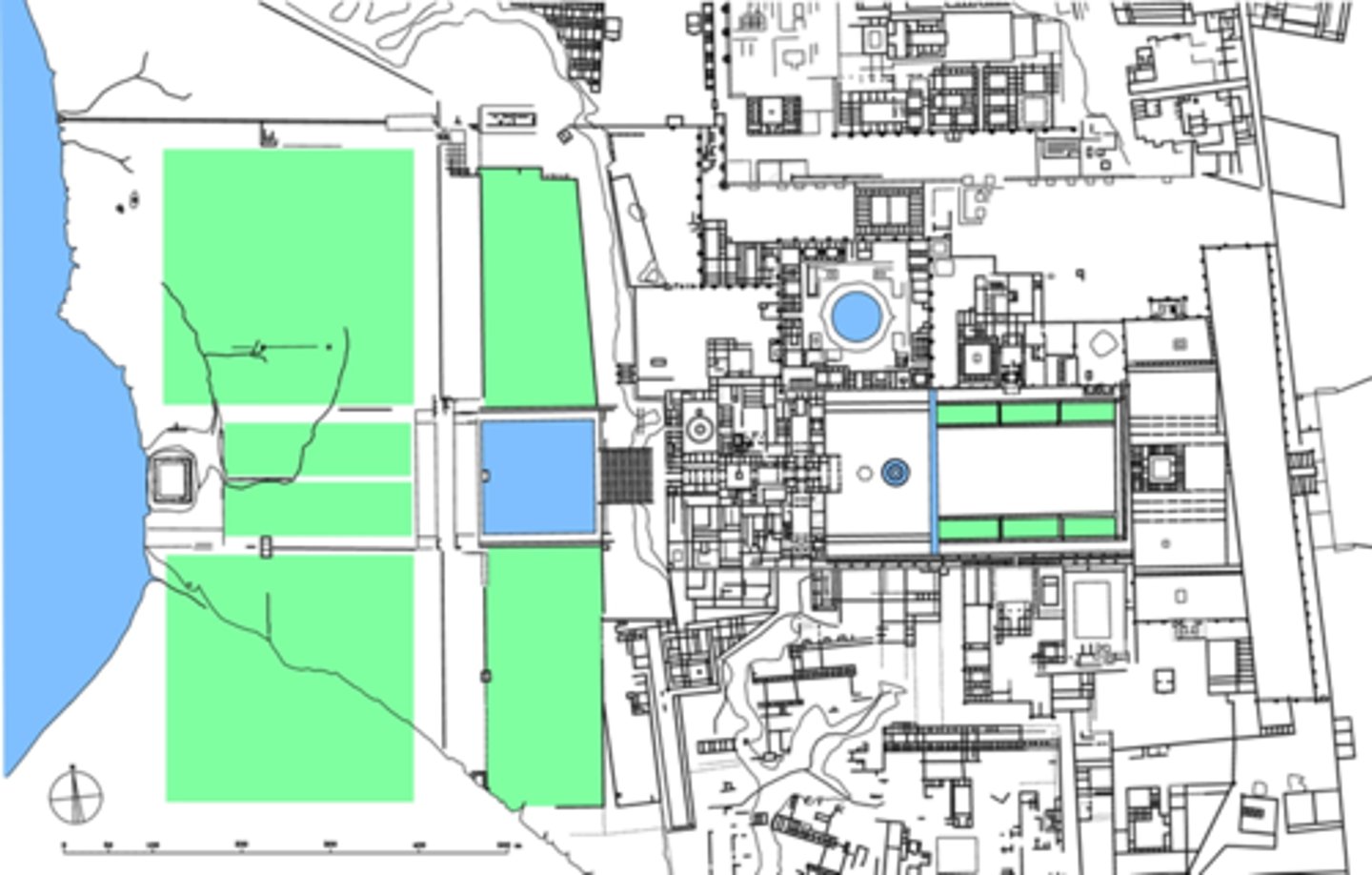
Qasr al-Khilafa, Samarra, 9th century, Abbasid
- Immense Caliphal palace with grand steps and gardens on the riverside entrance; even featured a water pipe irrigation system for the gardens
- e-Iwan gate @ the summit called the Bab al-Amma whose axis leads towards the throne room
- Sprawling polo grounds, racetrack, emphasis on leisure
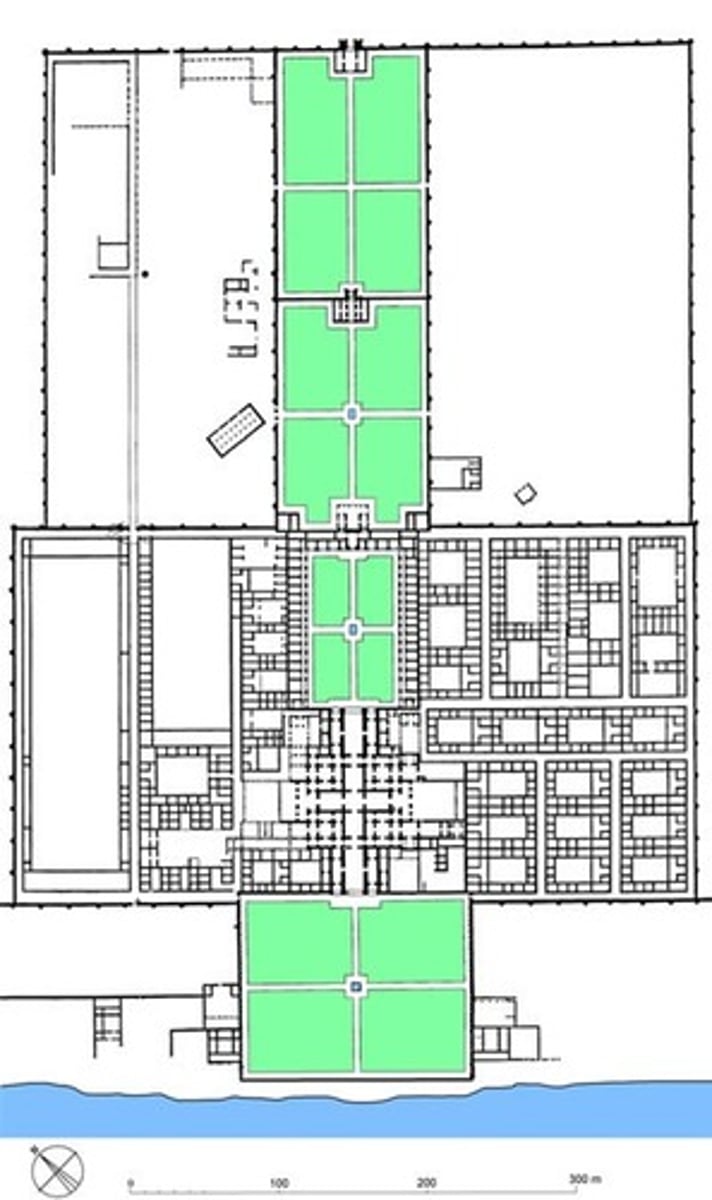
Balkuwara Palace, Samarra, 9th century, Abbasid
- Due to slight terracing, the throne room is the highest point of the palace
- caliph's throne room is located deep within the palace, keeping the caliph himself removed from public view, an increasingly mysterious and inaccessible figure
- Garden courtyard mosaic featuring green, gold, and mother of pearl and triple arched portal (leads to both throne room and garden courtyard)
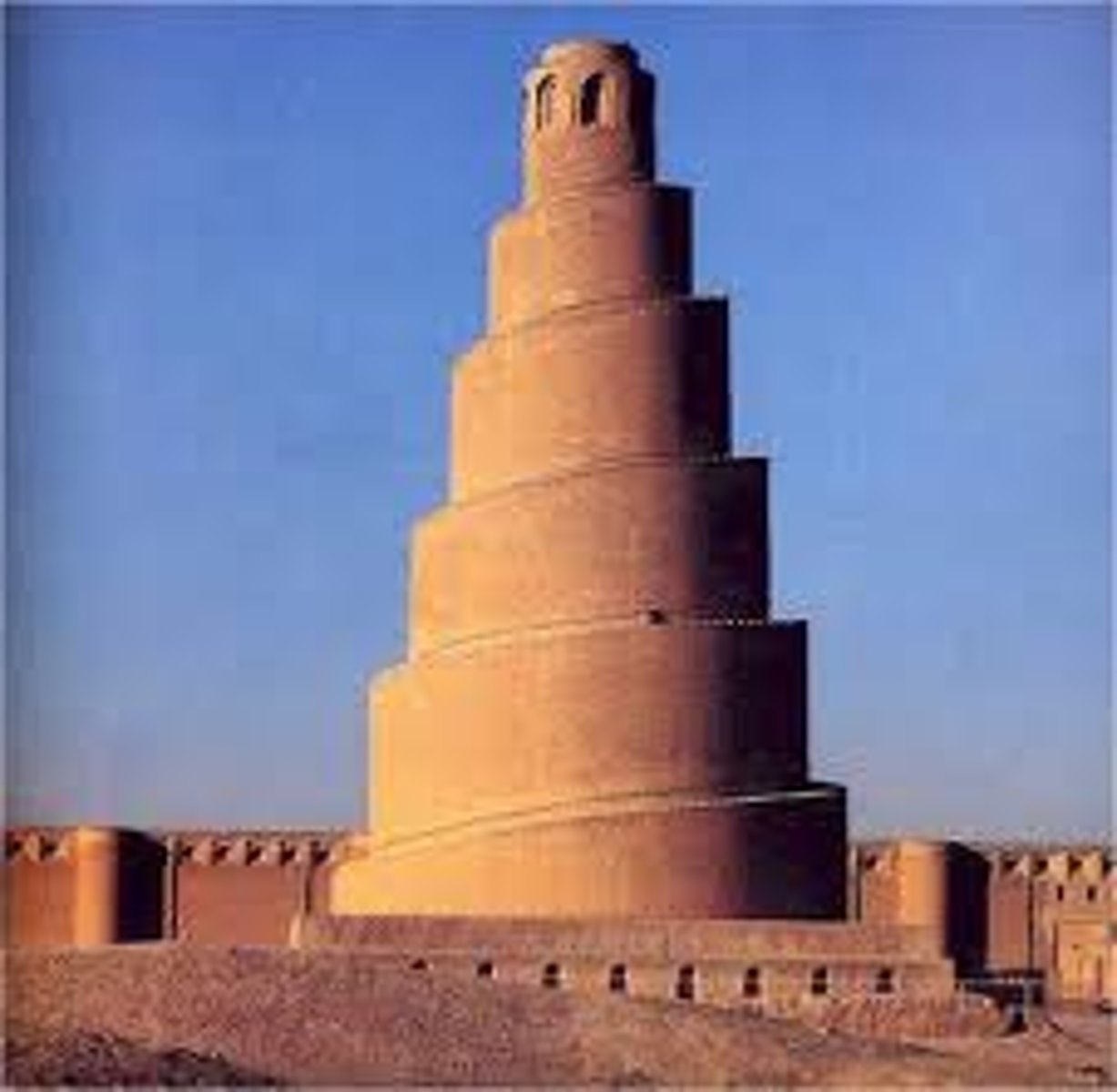
Great Mosque of al-Mutawakkil, Samarra (Iraq), 9th century, Abbasid
- the largest mosque in the Islamic world
- The Mosque’s Minaret —> The spiral is formed by a ramp that runs around and up the exterior of the minaret, with a surface wide enough to accommodate a rider on a donkey. (Said to be inspired by Byzantine Ziggurats)
- Samarran beveled style," it consisted of stucco that was carved while it was drying yet still malleable (faster and cheaper than brick or marble)
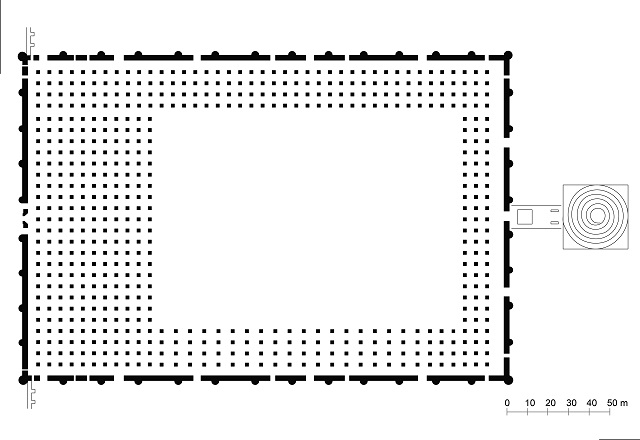

Masjid-i Tarikh, Balkh, 9th century, Abbasid
- The mosque was handsomely decorated with carved stucco covering
- the material presence in Balkh of stucco that so clearly resembles that of Samarra demonstrates that there was a real connection between the two areas and shows the reach of the Abbasids
- a small neighborhood mosque (not a congregational mosque) (proved by lack of courtyard and size)
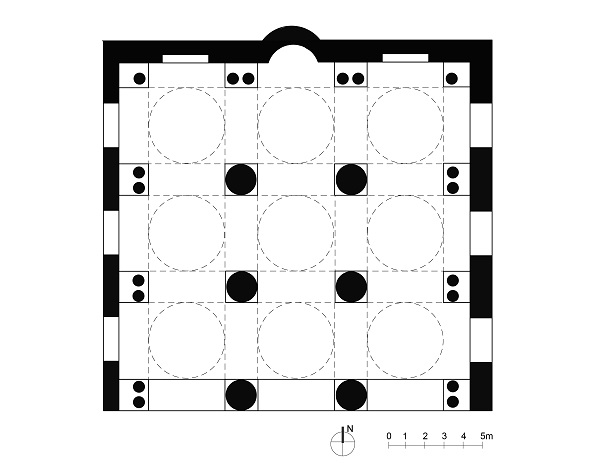
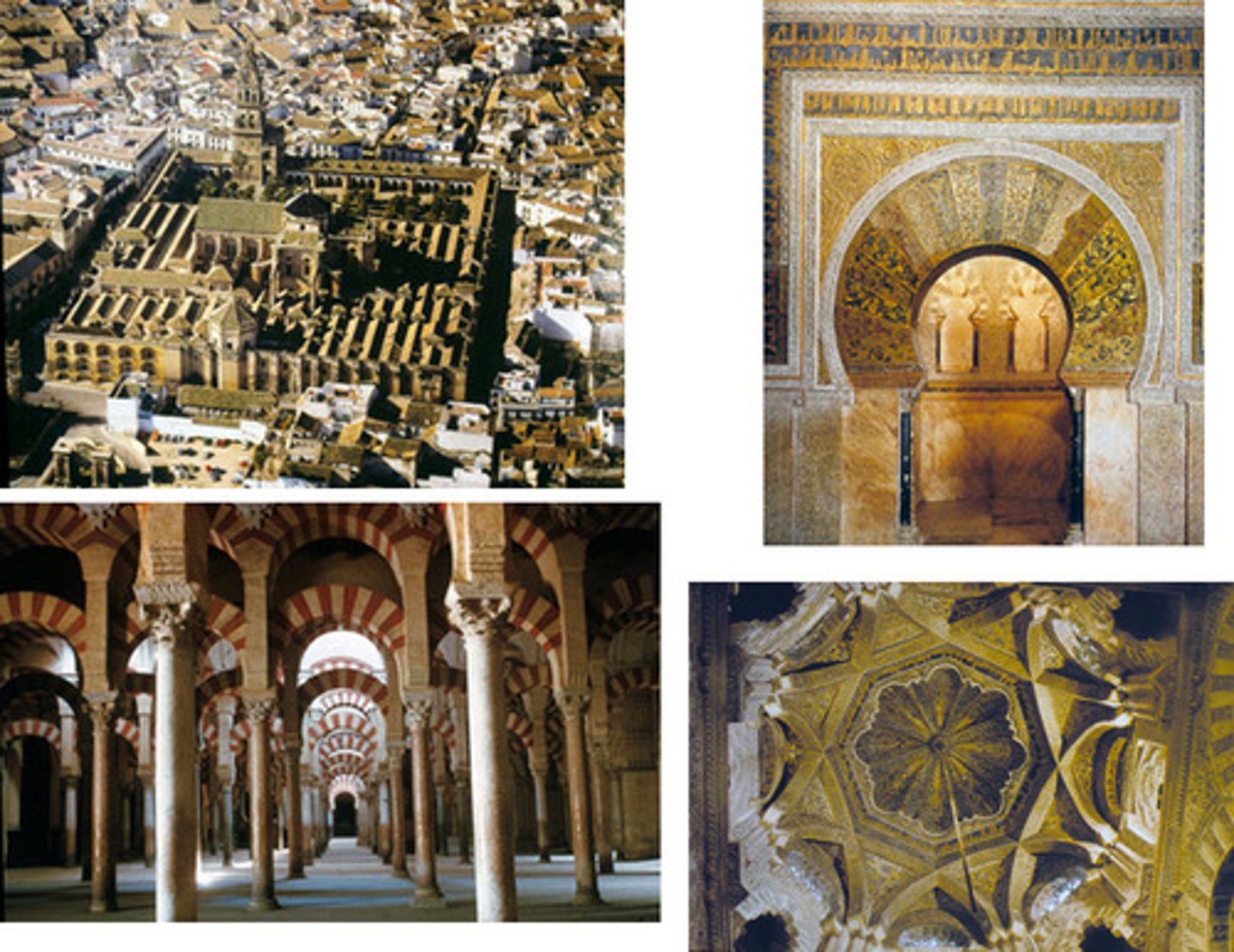
Great Mosque of Cordoba, Cordoba, Spain, 8th century, Hispano-Umayyad Dynasty
- arcades bore a two-tiered arcade, so that the ceiling was raised high overhead and inspired awe and wonder
- The red and white voussoirs in the arcades was surprising, beautiful, and so distinctive that in time it came to be a recognizable sign—a visual symbol—for the entire Cordoba mosque
- to the rising rate of religious conversion and population of the people who lived there meant the mosque had to be expanded numerous times
Built on site of Christian church
Portal of San Estaban: purely visual ornamentation on exterior around door
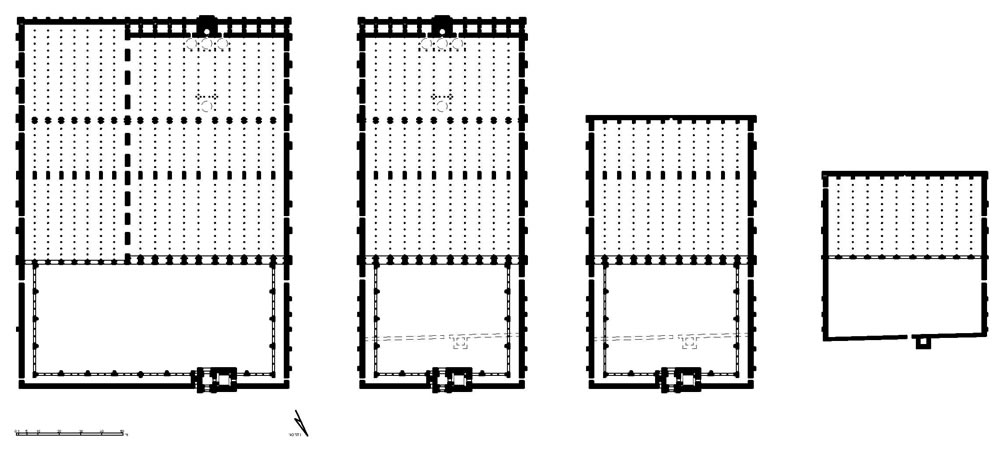
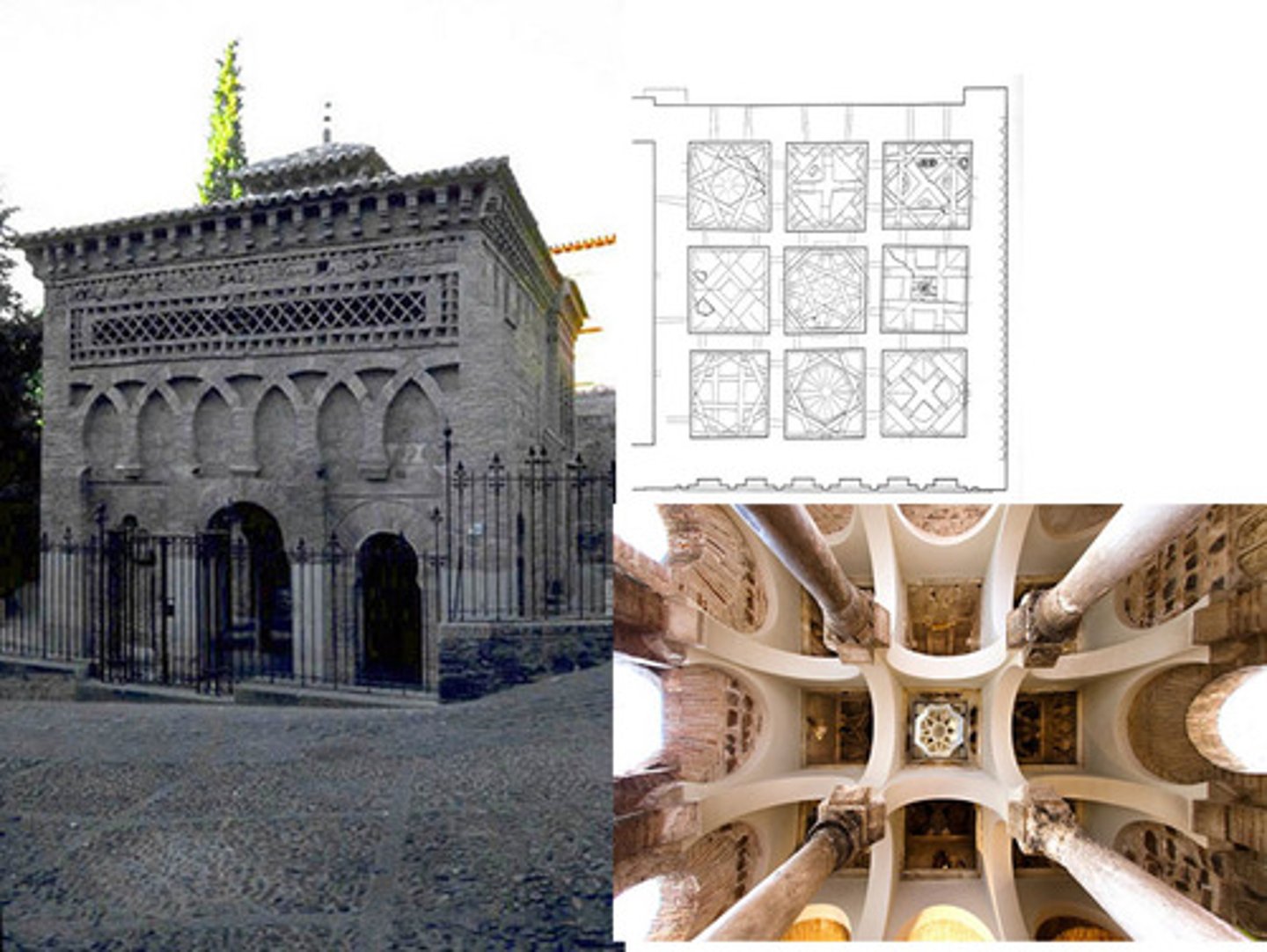
Bib Mardum Mosque, Toledo, 10th century, Hispano-Umayyad Dynasty
- 9 Unique domes that have symbolic function to remind viewers of cordoba (mother mosque)
- columns are made of spolia (reused material) bc it is practical and also a sign of conquest
- foundation inscription that tell us name and date of private patron and competition
Squinches are used —> small arch spanning corner of dome: creates transition from four side —> eight band; square base to round
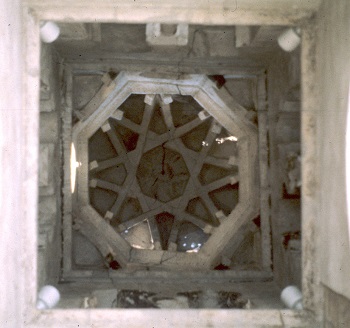
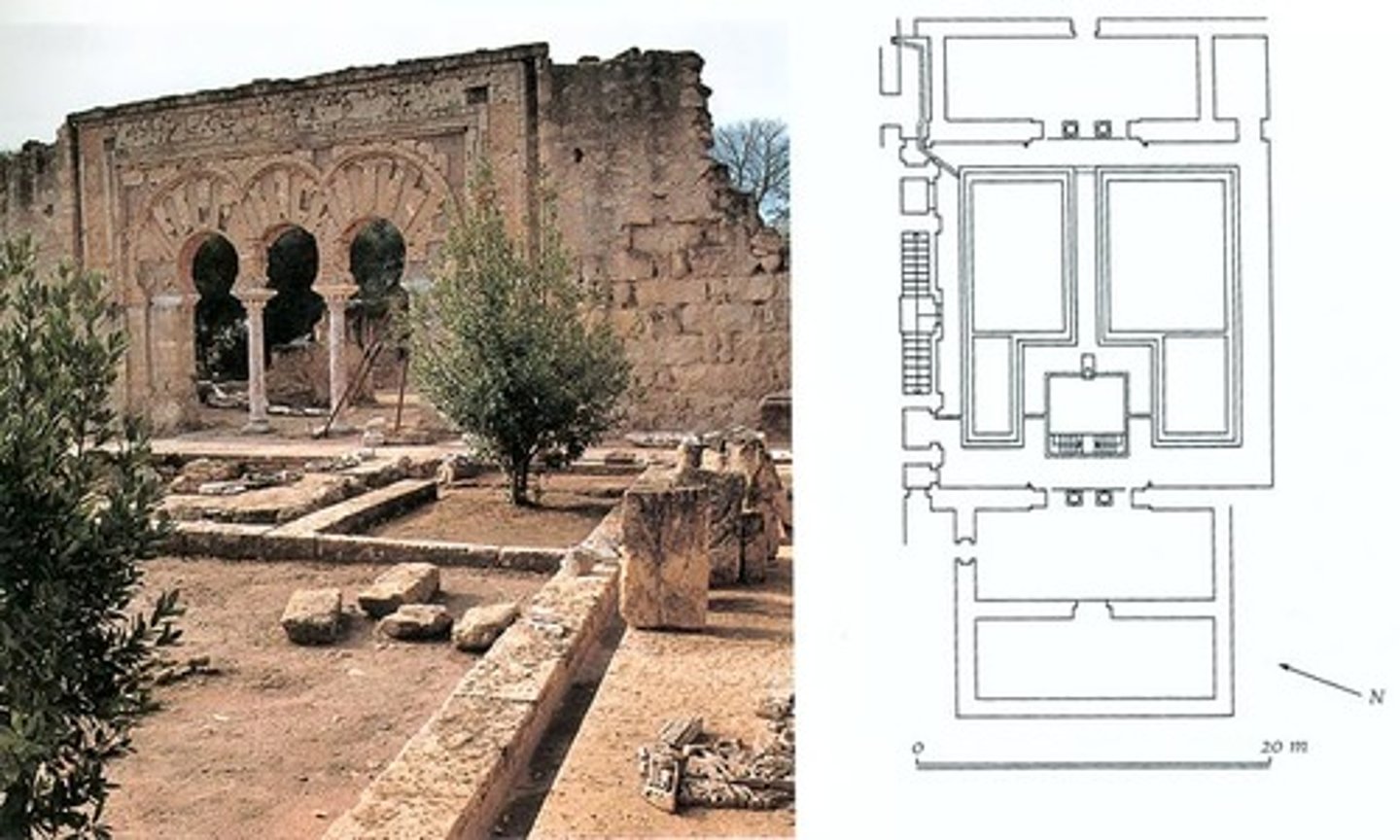
Madinat al-Zahra, Cordoba (Spain) , 10th century, Hispano-Umayyad Dynasty
- greatest of the suburban agricultural estates of cordoba (+ fiat city)
- The enormous size and splendor of Madinat al-Zahra was a clear expression of Abd al-Rahman III's new status as ruler of a kingdom
- three artificial terraces allowed the caliph to get an amazing view of his kingdom from his garden ( low: residential area and mosque, mid: huge terrace, high: Salon Rico)
Salon Rico: Reception hall; stucco and painted arches; used to look out over gardens = Supervision of Kingdom
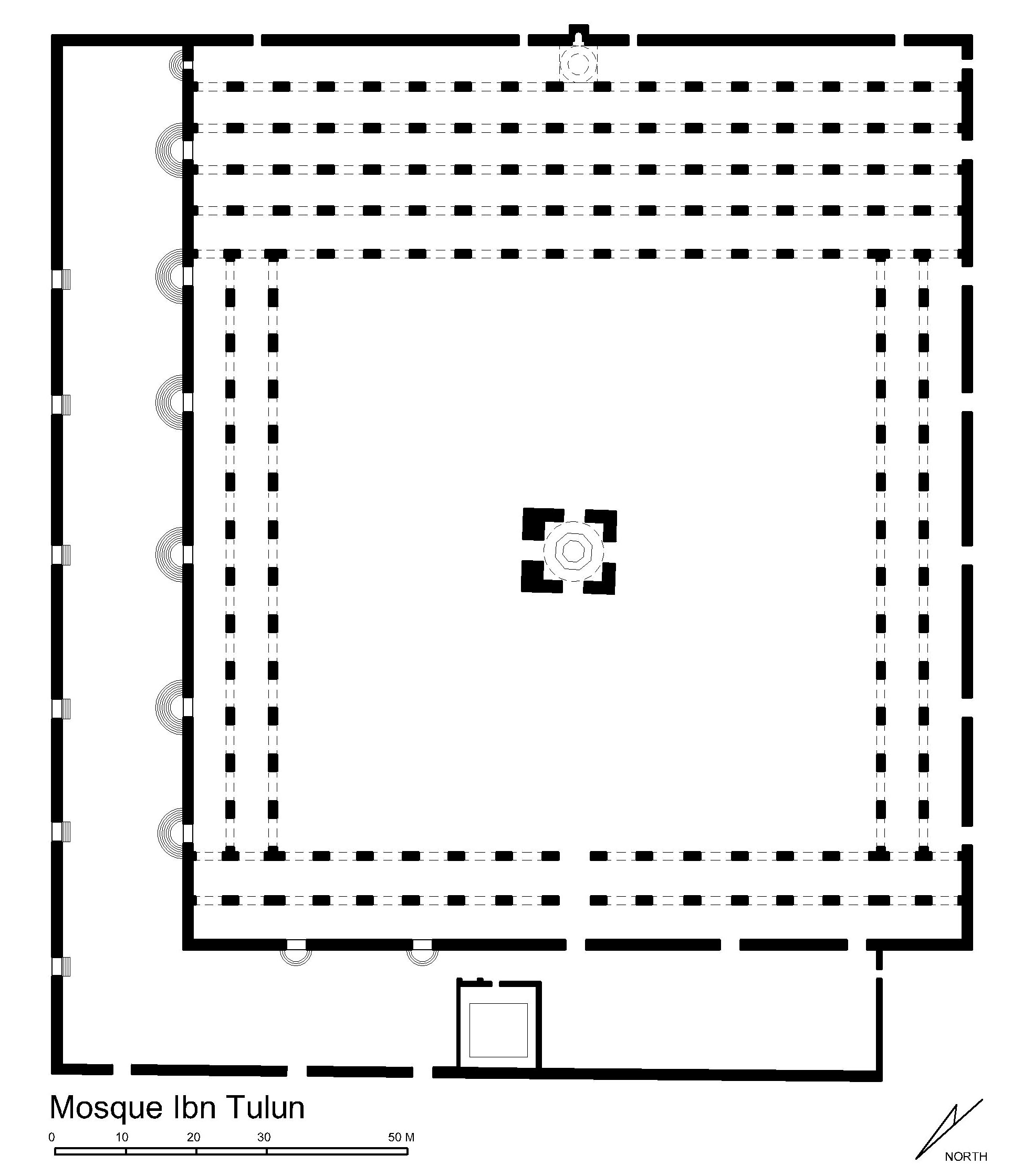
Mosque of Ibn Tulun, cairo, 9th century, the Tulunid dynasty
- It has an outer courtyard (ziyada) which functions as barrier between the mosque and the marketplace; (separates from Urban encroachment)
- spiral staircase is a copy of the mutawakkil (reveals Abassid influence)
- stucco is a substitute for marble in composite piers
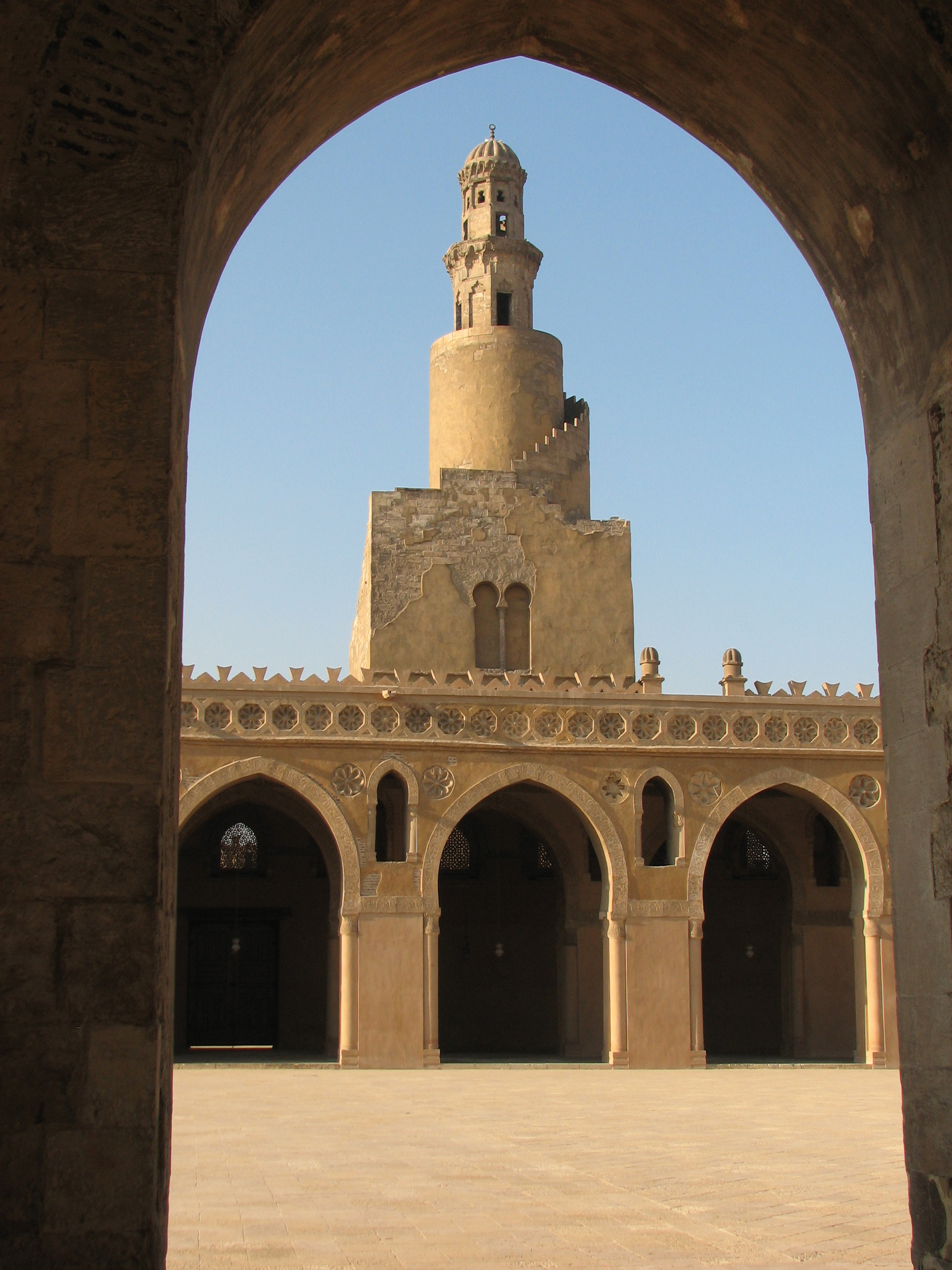
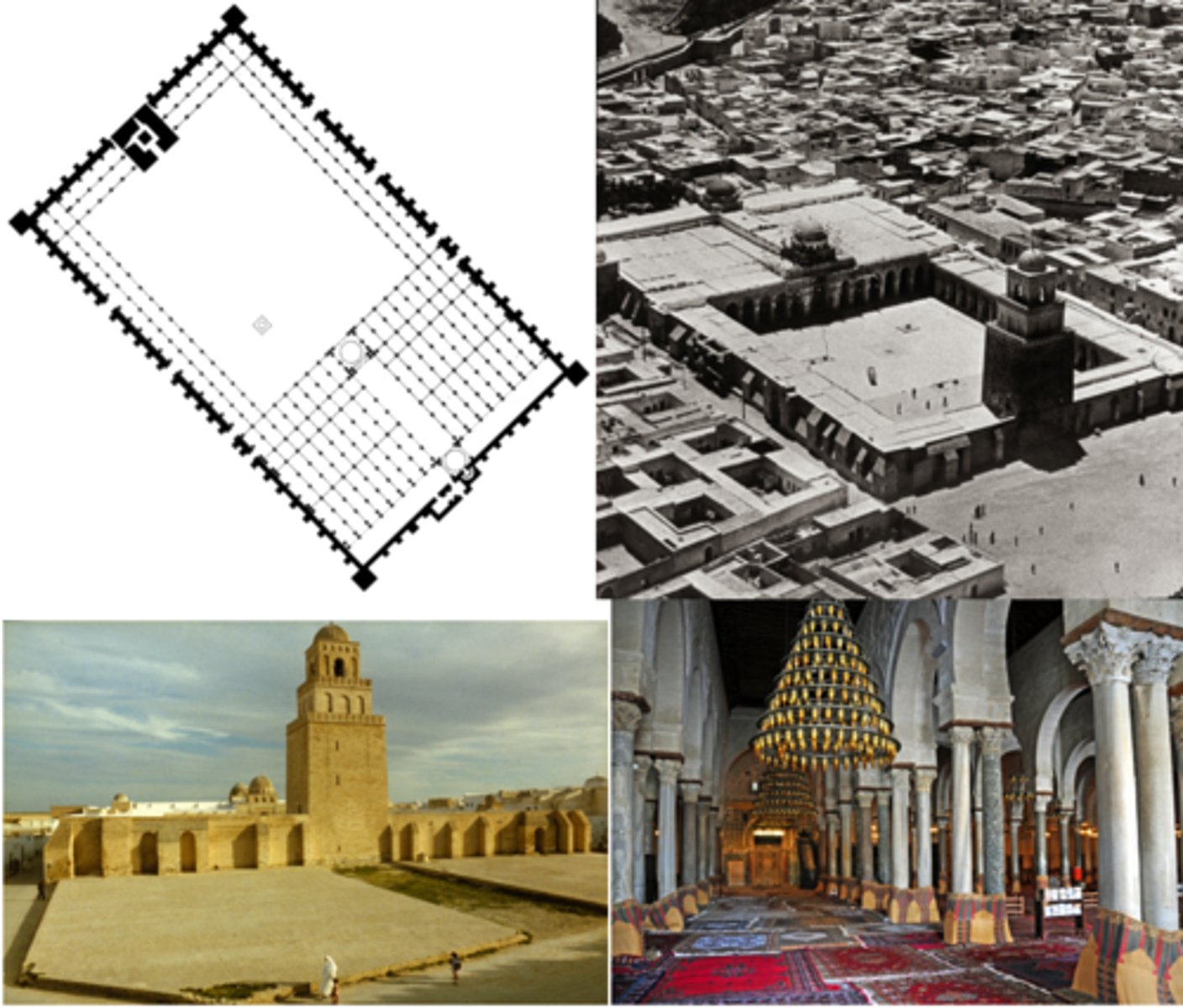
Great Mosque of Qairawan, Tunisia, 9th century, Aghlabid Dynasty
- With its hypostyle plan on spolia columns, the stone mosque could easily be expanded
- The mihrab was exquisitely ornamented. It had pierced marble panels in the curvature of the niche and golden lustre tiles embedded in its frame
- The dome overhead is fluted — sometimes described as a pumpkin dome because of its sensuously curved ribbed external surface.
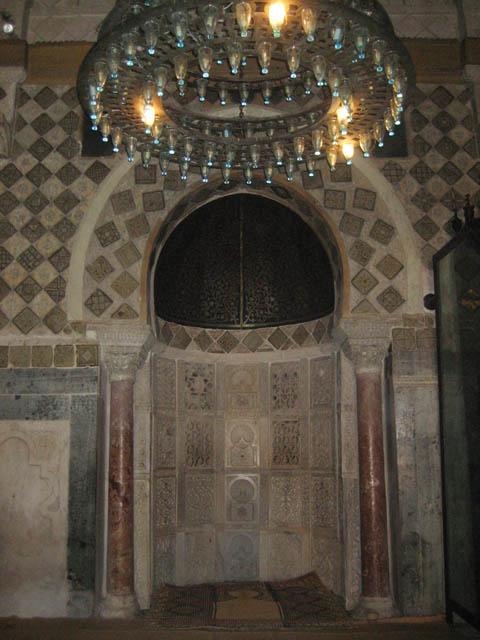

Mosque of al-Azhar, Cairo, 10th century, Fatamid
- one of two great congregational mosques Fatamids endowed in Cairo
- soon became a center of learning, and today it is part of the much larger, famed Azhar University.
- very little of the original architecture remains because of its constant use
Corner domes @ end of Qibla isle emphasize the organization of place and spacial hierarchy
Stucco ornamentation inspired by Ibn Tulun Mosque

Mosque of al-Hakim, Cairo, 10th century, Fatamid
Other great congregations mosque endowed by Fatamids in Cairo
- used to be located outside the city walls, but it was enclosed and included within the city when the walls were rebuilt in 1087.
- copies both the plan of the Ibn Tulun Mosque and the al-Azhar
- The southern minaret bears a foundation inscription with al-Hakim's name and the date 1003.

Mosque of al-Aqmar, cairo, 12th century, Fatimids
- Highly ornamented face with muqarnas and a medallion over the front entrance (symbols make allusion to shi’ism with a lamp, 6-pointed star, etc.)
- Introduction of skewed face: building that doesn't align with building interior (facade faces street @ angle)
- has foundation inscription of patron and date and quran inscription
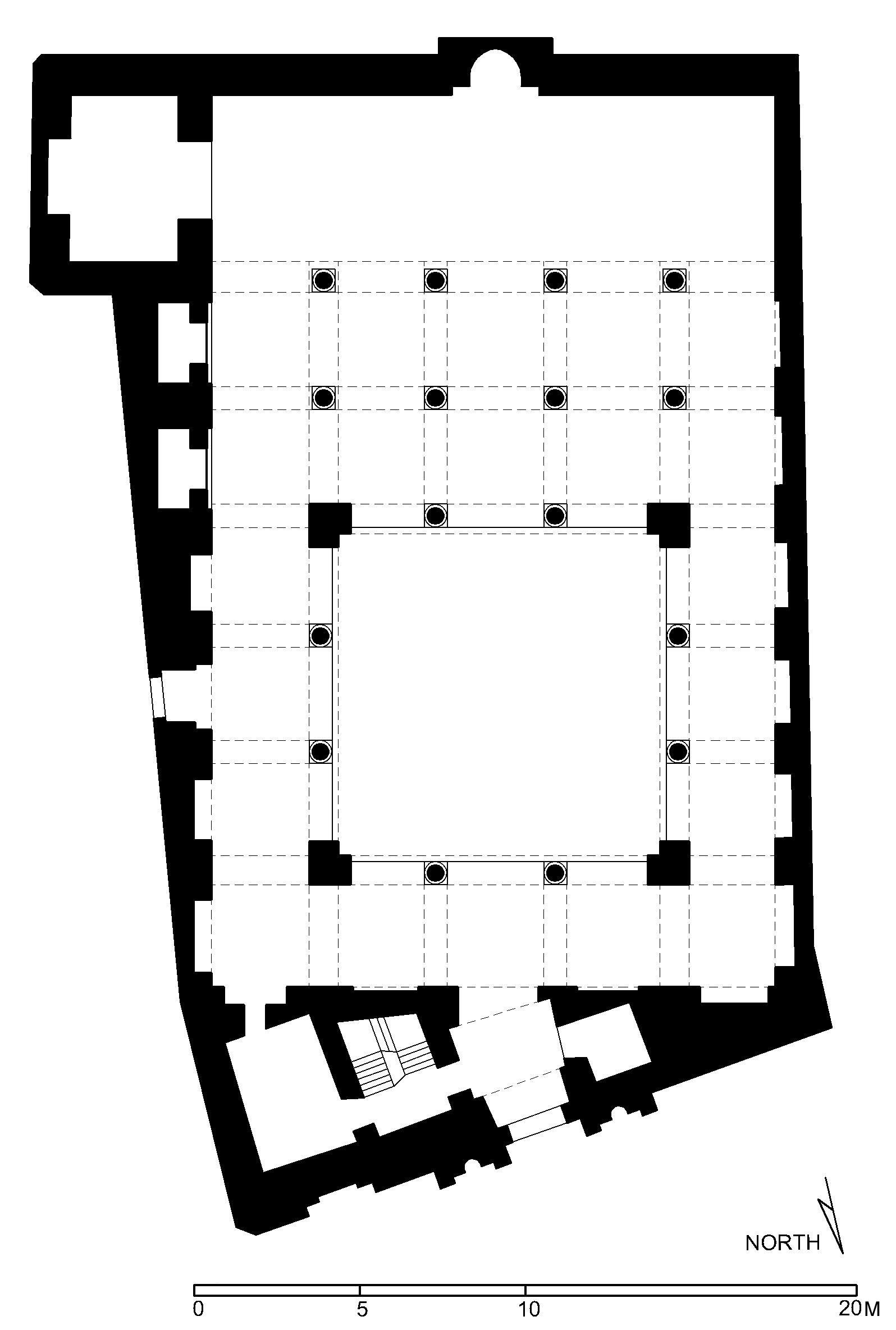
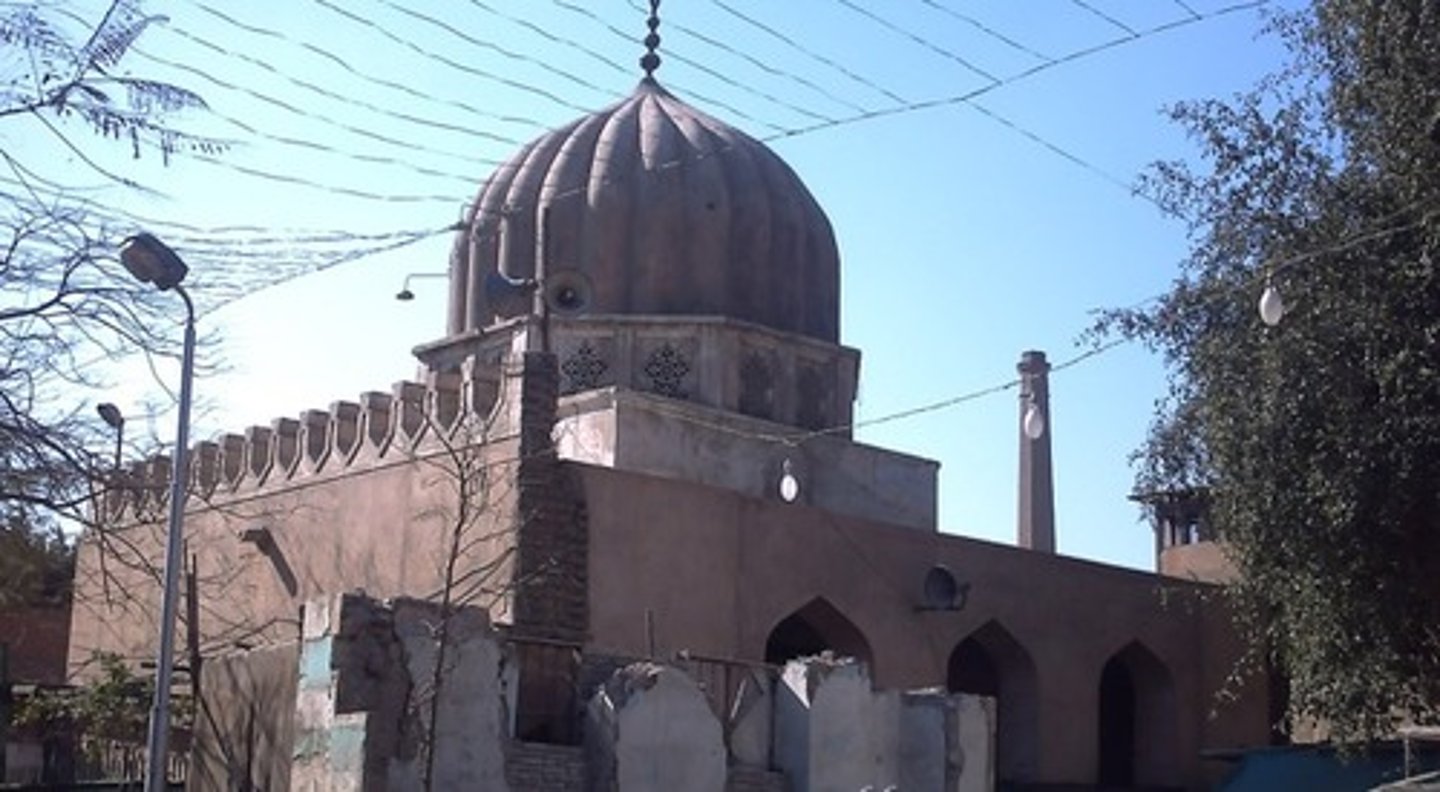
Mashhad of Sayyida Ruqayya, Cairo, 12th century, Fatimid Dynasty
- a shrine built in memory of one of the descendents of Ali and Fatima although she is not buried here (it is only for commeroative purposes
- has a lot of mihrabs so people could perform personal prayer although some view this as a polytheistic practice
- shrines like these are often more experimental which explains the tall octagonal dome because they express personal taste and not community values
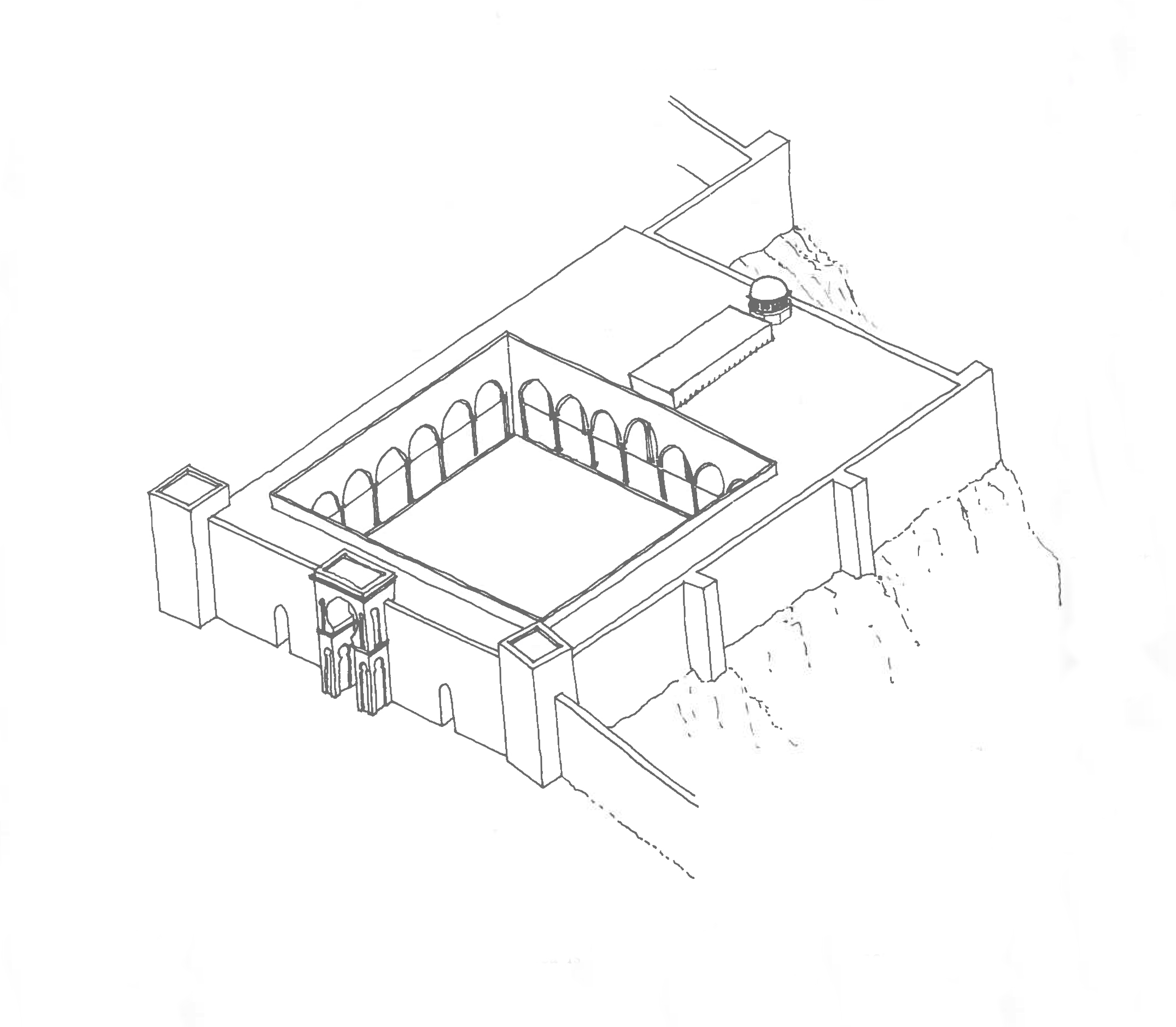
Great Mosque of Mahdiya, 10th century, Mahdiya, Fatimid Dynasty
-Birthplace of Fatimid Dynasty
Hypostyle mosque; mihrab marked by dome
elaborated facade with projecting portal and end towers give emphasis to exterior

Dome of the Rock
Mosque of Damascus
Anjar
Qasr al-Hayr East
Khirbat al-Mafjar
Mshatta
Musafa
What Buildings/Area were made in the Umayyad Dynasty?
Baghdad
Qasr al-Khilafa
Bulkuwara Palace
Great Mosque of Al-Mutawakkil
Masjud-i Tarikh
What buildings/areas were in the Abbasid Dynasty?
Great Mosque of Cordoba
Bib Mardum Mosque
Madinal al-Zahra
What buildings/areas were in the Hispano-Umayyad Dynasty?
Mosque of Ibn Tulun
What buildings/areas were in the Tulunid Dynasty?
Great Mosque of Qairawan
What buildings/areas were in the aghlabid Dynasty?
Mosque of al-Azar
Mosque of al-Hakim
Mosque of al-Aqmar
Mashhad of Sayyida Raqayya
Great Mahdiya Mosque
What buildings/areas were in the Fatimid Dynasty?
Mecca and Medina
What are the two principal cities of early Islam?
Profession of Faith, prayer, charity, fasting during Ramadan, and Pilgrimage (hajj)
What are the Five Pillars of Islam (use either the English or Arabic terms).
Medina. Enclosed, oriented, infinitely expandable, and egalitarian
Where was the Prophet’s House (and thus first mosque) located and what are its defining characteristics?
South
From the Prophet’s House, in what direction would the faithful face when they prayed?
Pilgrimage is required once in the lifetime of a capable Muslim. The hajj draws the Muslim community together from disparate areas of the Islamic world and thus forms a cultural crossroads for the exchange of ideas about society as well as art and architecture.
What is the significance of the hajj, and what specific impact does it have for Islamic art and architecture?
Set of steps from which the imam delivers the sermon to the congregation; pulpit of a church or the Bima of a synagogue
What is a minbar and what is its function? Do Christian churches and Jewish synagogues have similar devices?
The direction of Mecca from any point in the world → in Muslim prayer, face the Qibla; wall of the mosque closest to Mecca is called the Qibla Wall
What is the Qibla?
Strongly shuns images in religious environments, but not in more secular environments like palaces/scientific/literary books → not to avoid human and animal images but to avoid the temptation of idolatry
Does Islamic art ban figural images?
661-750 CE
What are the dates of the Umayyad dynasty?
Romans and Byzantines (among others). It supplied already developed road and urban systems, as well as techniques, motifs, formal types, and ideas for art and architecture.
Underlying the newly conquered Islamic landscape was a landscape already shaped and built by whom? What effect did this have on early Islam?
Reused architectural materials
What is a Spolia?
A large nave runs from the central mihrab to the courtyard. It creates a new mihrab axis that emphasizes the space as being hierarchically more important than the surrounding aisles.
The House of the Prophet in Madina became the first mosque. What changes to mosque planning were introduced with the Great Mosque of Damascus and how did these affect the egalitarianism that was such a striking characteristic of that first mosque in Madina?
They are aniconic, meaning that instead of images of people, there are images of plants and trees, objects, geometrical ornament, and inscriptions.
How are the mosaics in the Dome of the Rock and the Great Mosque of Damascus different from mosaics found in Byzantine churches?